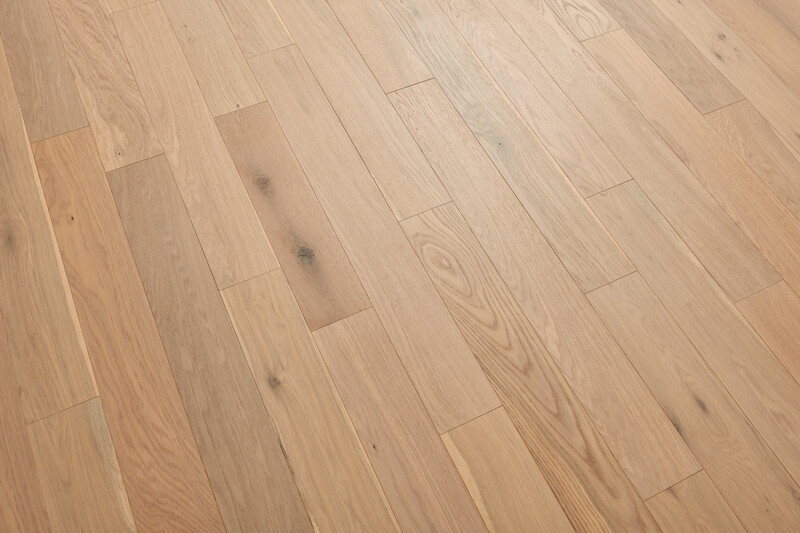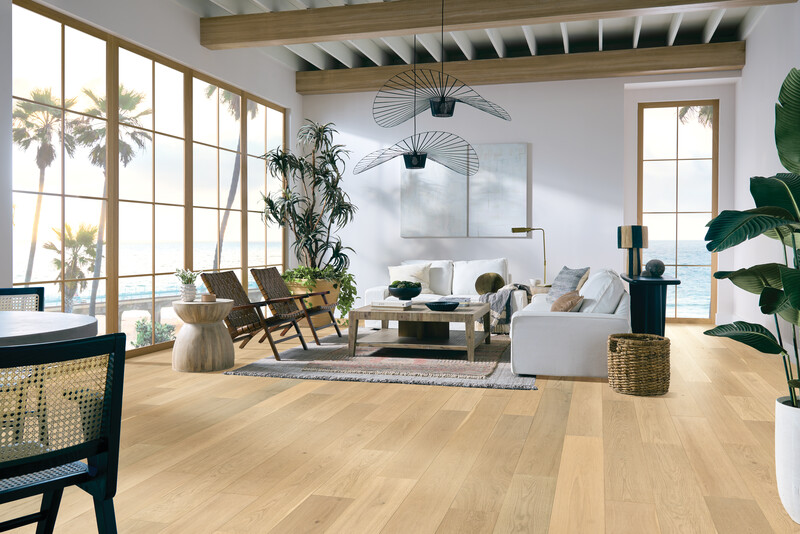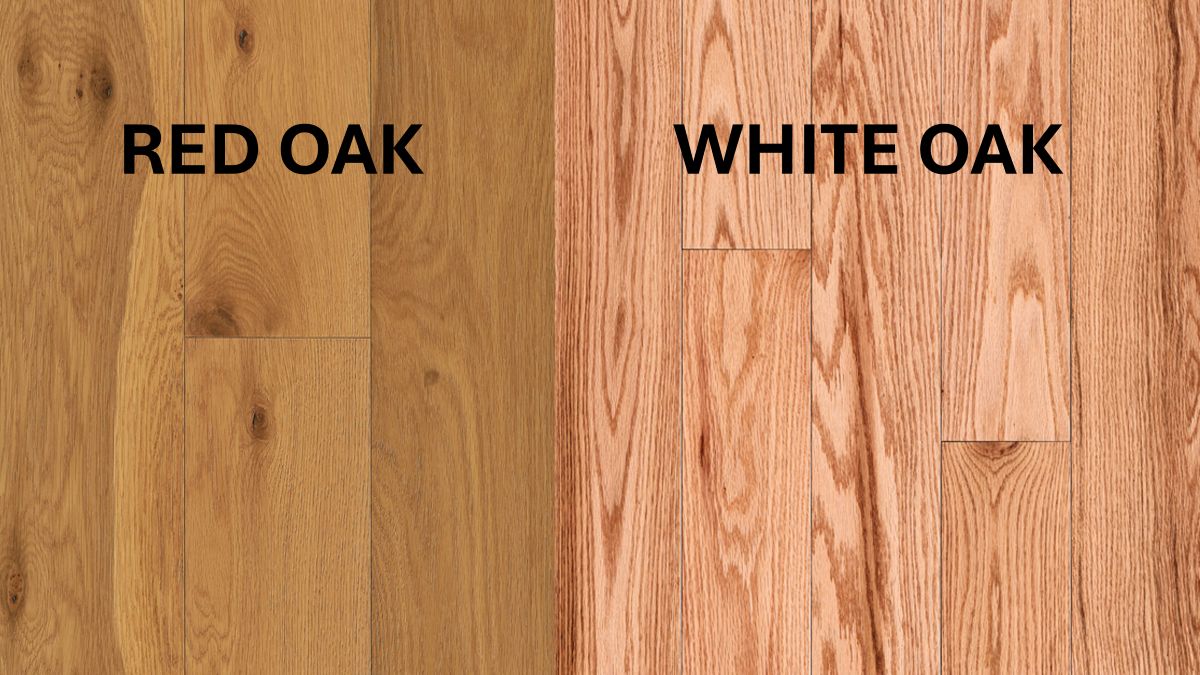White Oak Flooring – Its Grain, Tone, and Texture
White oak flooring has earned a long-standing place in homes and design magazines alike. Known for its balance of beauty, durability, and versatility, this hardwood adapts to nearly any interior style. It works beautifully in everything from an old farmhouse to minimalist Scandinavian to modern industrial.
In this guide, we’ll break down what sets it apart. Its grain, tone, texture, durability, construction types, how it compares to red oak, and how to decorate around it. We’ll also touch on cost and sustainability.

Oak’s Grain: Straight and Refined
One of the most recognizable traits of this species is its tight, linear grain pattern. Unlike red oak, which often features dramatic, wavy arches (known as “cathedrals”), white oak appears smoother and more uniform.
The result is a clean, uncluttered appearance — ideal for contemporary or minimalist interiors. For those who still want character without chaos, it’s the best of both worlds.
Tone: Naturally Neutral
The natural color of white oak flooring ranges from light beige to soft brown, often with a grayish or golden tint. These neutral undertones make it highly stain-friendly. You can opt for a light and airy look with a clear finish or a bold and moody style with dark espresso tones.
Whether you want a coastal, farmhouse, or modern aesthetic, it works as a strong yet subtle base.
Texture: Smooth to Rustic
This hardwood wears a variety of textures well, from smooth, sanded finishes to wire-brushed, hand-scraped, or even distressed appearances. Its dense grain helps finishes hold up over time, especially in wide-plank formats.
Wire brushing, in particular, enhances the wood’s natural structure. It makes it both stylish and practical for hiding everyday wear.
Durability and Hardness
Rated at about 1360 on the Janka scale, it’s tougher than red oak and more resistant to dents and scratches. Its closed grain structure also gives it better resistance to moisture and spills, making it a smart pick for kitchens, hallways, and entryways.
Combined with a proper finish, this hardwood holds up well in homes with pets, kids, or heavy foot traffic.
Solid vs. Engineered: What’s the Difference and Why It Matters
The construction of your hardwood floor matters just as much as the species. Choosing between solid white oak flooring and white oak engineered hardwood depends on where and how you plan to install it.
Solid White Oak Flooring
Manufacturers create solid oak hardwood from a single piece of hardwood. The upside is that you can sand and refinish the floors multiple times, extending their life for decades.
Although oak flooring is one of the more water-resistant options, it remains best suited for above-grade installation. Think of living rooms, dining rooms, bedrooms, and so on.
White oak remains one of the most popular hardwood options, known for its traditional look and long-term value.
Solid construction is ideal for homeowners who want floors that can last for generations.
White Oak Engineered Hardwood
Engineered white oak flooring features a top layer of genuine hardwood bonded to a stable plywood or HDF core. That construction adds stability to the planks, reducing the impact of moisture. As a result, planks expand and contract less.
That means you can install engineered white oak in basements, over radiant heat, or directly over concrete.
Engineered options are also more often available in wider planks. For example, Robbins® offers Seaboard™, a premium white oak engineered hardwood in 7 1/2″ planks.

The flooring features fewer knots and streaks, resulting in a more pristine appearance. It also goes beyond water resistance to complete six-sided waterproof protection for up to 8 hours. It also comes with a limited lifetime warranty against structural defects for as long as you own your hardwood floor.
Styling Interior Spaces with White Oak Flooring
Designing around this hardwood is surprisingly easy — and that’s one of its most significant advantages. Thanks to its cool-to-neutral undertones and smooth grain, white oak works as a quiet backdrop or a featured design element. Whether you’re building from scratch or refreshing a space, it adapts to nearly any aesthetic.
Light floors open a room and bounce natural light. They allow furniture, art, or architectural details to take center stage. Stained or darker finishes offer contrast and coziness, ideal for more layered or dramatic interiors.
Because of this flexibility, white oak flooring pairs well with a wide range of colors, materials, and design styles:
- Cool palettes: Soft grays, navy, charcoal, and sage look crisp and sophisticated.
- Warm tones: Terracotta, camel, mustard, and olive bring out the wood’s natural warmth.
- Textural companions: Linen, matte black, brass, marble, concrete, and of course, more wood.
From coastal to industrial, minimalist to vintage, white oak lets your style take the lead, never overpowering, always supporting.

White Oak vs. Red Oak: A Side-by-Side Look
While red oak has charm, the more refined and flexible look of its cousin has made it the go-to for designers and remodelers.
| Feature | White Oak | Red Oak |
| Grain | Tight, smooth, straight | Wavy, open, more variation |
| Tone | Cool, neutral | Warm, pinkish-red |
| Durability | Higher (Janka ~1360) | Slightly lower (Janka ~1290) |
| Water Resistance | Better | More porous |
| Design Style | Modern, minimalist, transitional | Rustic, traditional |
Cost Compared to Other Hardwoods
Here’s how white oak flooring stacks up against other hardwood options for cost (pricing varies by region and finish):
| Species | Price Range |
| Bamboo | $2-6 |
| Brazilian walnut | $5-10 |
| Cherry | $4-7 |
| Cypress | $4-6 |
| Hickory | $3-7 |
| Mahogany | $6-8 |
| Maple | $3-10 |
| Pine | $2-4 |
| Red oak | $2-6 |
| Teak | $9-13 |
| White ash | $5-8 |
| White oak | $4-7 |
Source: This Old House
Both solid and engineered options offer strong mid-range value. Engineered flooring is often slightly less expensive to install and more versatile across different subfloors.
Sustainability Considerations
White oak is a widespread species throughout the United States, making it one of the more sustainable hardwoods. Engineered versions maximize material efficiency and reduce waste. Many products today are available with low-VOC finishes that contribute to healthier indoor air quality.
White Oak Flooring – Versatile, Durable, Stylish
Few flooring options offer the total package like white oak. It brings a clean, adaptable look that works across styles. It suits equally well for rustic and high-scale interiors, as well as everything in between. It also provides the durability to withstand daily wear.
Select solid white oak flooring for its long-term value and the ability to be refinished over time. Opt for white oak engineered hardwood if you need more flexibility with installation or moisture resistance.
Whichever route you take, Robbins offers more than 100 selections of solid and engineered white oak flooring. It backs many of those options with a limited lifetime warranty against structural defects for as long as you own your hardwood floor.
Find the ideal white oak hardwood at a nearby Robbins retailer.
